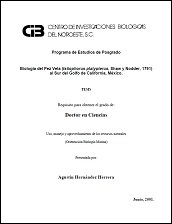Isotopic Niche Variation in a Higher Trophic Level Ectotherm: Highlighting the Role of Succulent Plants in Desert Food Webs
Autor
Miguel Delibes
MARIA DEL CARMEN BLAZQUEZ MORENO
Metadatos
Mostrar el registro completo del ítemResumen
"Stable isotope analysis of animal tissues allows description of isotopic niches, whose axes in an n-dimensional space are the isotopic ratios, compared to a standard, of different isotope systems (e.g. δ13C, δ15N). Isotopic niches are informative about where an animal, population or species lives and about what it consumes. Here we describe inter- and intrapopulation isotopic niche (bidimensional δ13C-δ15N space) of the Orange-throated whiptail (Aspidoscelis hyperythra), an arthropodivorous small lizard, in ten localities of Baja California Sur (Mexico). These localities range from extreme arid to subtropical conditions. Between 13 and 20 individuals were sampled at each locality and 1 cm of tail-tip was collected for isotope analysis. As expected, interpopulation niche width variation was much larger than intrapopulation one. Besides, isotopic variation was not related to age, sex or individual size of lizards. This suggests geographic variation of the isotopic niche was related to changes in the basal resources that fuel the trophic web at each locality. The position of Bayesian isotope ellipses in the δ-space indicated that whiptails in more arid localities were enriched in 13C, suggesting most of the carbon they ingested came from CAM succulent plants (cacti, agaves) and in minor degree in C4 grasses. Contrarily, whiptails in subtropical areas were depleted in 13C, as they received more carbon from C3 scrubs and trees. Localities closer to sea-level tended to be enriched in 15N, but a clear influence of marine subsidies was detected only at individual level. The study contributes to identify the origin and pathways through which energy flows across the trophic webs of North American deserts."
Colecciones
Ítems relacionados
Mostrando ítems relacionados por Título, autor o materia.
-
PROMOCIÓN DEL PERIFITON PARA EL CULTIVO DE CAMARÓN BLANCO: HACIA UNA ACUICULTURA ECOLÓGICA
DOMENICO VOLTOLINA LOBINA; JUAN MANUEL AUDELO NARANJO; MARIA DEL ROSARIO PACHECO MARGES -
Suelo y Erosión
YOLANDA LOURDES MAYA DELGADO


